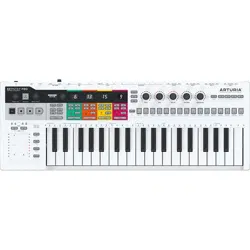Loading ...
Loading ...
Loading ...

!: A nifty trick is to start an arpeggio or sequence in a certain scale, then select another scale with the
'Shift' + Scale key option. You'll hear your arpeggio or sequence change scales on the fly. Remember,
the KeyStep Pro has three arpeggiators, on Tracks 2-3-4.
!: You can also use the Pitchbend strip to change the pitch of your arpeggio.
When Scale mode is active, this can have a peculiar effect on your arpeggio or sequence:
because all notes will be forced to play in the currently selected scale, there may be
duplicate notes. For example, if you've set the scale to C major and you hold down an E
and an Eb, because the Eb is 'foreign' to the C major scale, the Arpeggiator will play E twice,
which causes a ratcheting effect.
5.5.1.2. The Scale Root
'Shift' + Root (F in the upper octave) allows you to select another root note for the currently
playing sequence:
For Major, Minor, Dorian, Mixolydian, Harmonic Minor and Blues scales, you can select a new
root note by pressing 'Shift' and holding down the Root key.
Let go of the 'Shift' key and select a new root in the first octave of the keyboard. As long as
you keep holding down the Root key, pressing a key will update the root note. The currently
active root note will be shown with its LED lit up continuously in blue.
Starting a scale on a different note will drastically change the mood or feeling. For example,
if we play the notes that make up the C major scale not from C to C' but from D to D', the
intervals will now be heard in a different order.
• C major starting on C: tone, tone, semitone, tone, tone, tone, semitone (T-T-s-T-T-
T-s).
• C major starting on D: tone, semitone, tone, tone, tone, semitone, tone (T-s-T-T-T-
s-T = Dorian mode).
When you take this second series of intervals and start on, say, G as the root note, you get:
• G, A, Bb, C, D, E, F, G' (known as G Dorian)
It's an age-old principle that was widely used in ancient music and medieval church music.
It was rediscovered by jazz musicians in the 1950s and 1960s. And when the western world
opened up to other music cultures, especially in the 1980s and 1990s, musicians explored
the exotic-sounding scales of Indian ragas and Arabic maqams, which used some scales
that were quite different to the standard major and minor scales that had been used for
centuries in western classical music.
Changing the root note is a form of 'intelligent' transpose — intelligent because the interval
structure of the scale remains intact. This, as opposed to normal or 'dumb' transpose, which
simply lowers or raises all the pitches by the same interval.
♪: If you want to know more about this fascinating subject, search "music theory" on a search engine
or YouTube.
110 Arturia - User Manual Keystep Pro - Making Tracks
Loading ...
Loading ...
Loading ...
